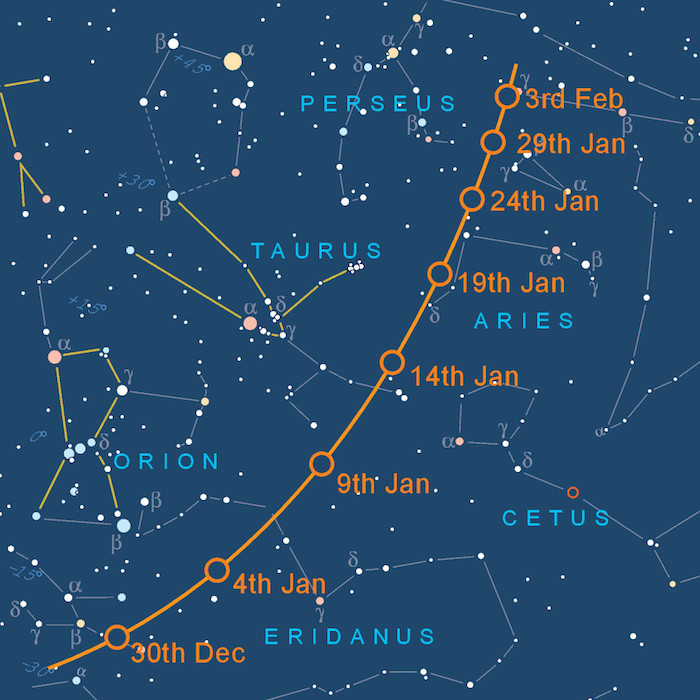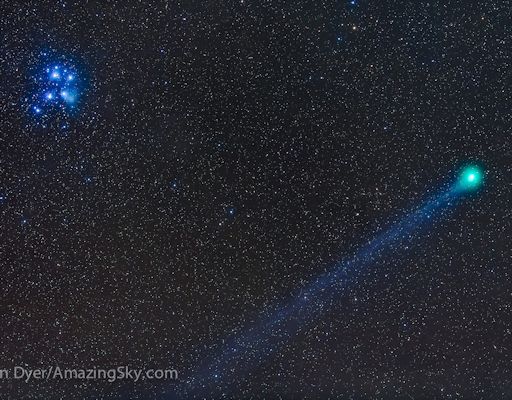With a high orbital inclination of 80°, Comet Lovejoy is approaching the ecliptic from below which has favoured Southern Hemisphere observers until now, but that’s all about to change as the comet rapidly heads north.
.
As 2014 draws to a close, C/2014 Q2 Lovejoy is already shining at magnitude +5 and lies in the constellation of Lepus the Hare, culminating at an altitude of about 15° by 10:30 pm for UK-based observers — but conditions are set to improve rapidly as it heads north at a rate of about 2° per day. Image credit: AN graphic by Greg Smye-Rumsby
The waxing gibbous Moon is currently interfering with observation of the comet, but binocular observers with an unobstructed view of a southern horizon that’s also free of light pollution should scan southern Lepus about 15° below Rigel in Orion around 10:30 pm to stand a good chance of viewing the diffuse puffball glow of C/2014 Q2.
Currently at magnitude +5 (or brighter) it should still be obvious in moonlight, particularly in a telescope. While numerous astroimages show Comet Lovejoy sporting a thin ion tail about 5° long, the visual impression is that of a slightly asymmetric ball concentrated towards the centre. That was how it appeared in my 10×50 binoculars at 10 pm GMT on 29th December.
As the nights pass, Comet Lovejoy heads north-northwest, passing into the constellation of Eridanus in early January. By the night of Full Moon on 5th January, the comet will be 11° directly west (right) of Rigel, much higher in the sky and easily identifiable despite the Moon’s glow in Gemini.
Comet Lovejoy at its best
With the waning gibbous Moon (you can check the rise/set times with our Almanac) comes the best part of this cometary apparition. C/2014 Q2 makes its closest approach to the Earth on 7th January 2015 at 0.469 Astronomical Units (43.6 million miles; 70.2 million kilometres).
Comet Lovejoy crosses the celestial equator on 9th January 2015 and moves into Taurus — hopefully a comfortable naked-eye object by now — before passing into Aries on January 16th. A nice wide-angle astrophoto opportunity occurs on January 18th when C/2014 Q2 passes about 9° from the Pleiades.
With New Moon occurring on 20th January we have to be mindful of the returning lunar glow and Comet Lovejoy moves into the constellation of Triangulum on the 25th. The comet reaches perihelion on 30th January 2015 at a distance of 1.29 AU (120 million miles; 193 million kilometres) from the Sun, by which time we will see C/2014 Q2 heading for a close conjunction with beautiful double star Almach (gamma Andromedae) on 4th February.
For observers with equatorially-mounted telescopes or GoTo instruments, the table below lists the daily J2000 Epoch coordinates of right ascension (R.A.) and declination (Decl.) for Comet Lovejoy at Oh UT throughout the brightest part of the comet’s visibility. The column labelled Delta is the comet’s distance from the Earth in Astronomical Units (1 AU = 92.9 million miles or 149.6 million kilometres), while r is the comet’s distance from the Sun, also in AU.
---
Quelle: AN
Comet C/2014 Q2 Lovejoy Near M79
Taken by rolando ligustri on December 29, 2014 @ from Australia near SSO, ITelescope
Quelle: Spaceweather
.
Update: 8.01.2015
.
BRIGHTENING, GORGEOUS COMET: Comet Lovejoy (C/2014 Q2) continues to brighten, and it can now be seen with the naked eye even from light-polluted urban areas. Science journalist and longtime comet watcher Mariano Ribas reports from the Planetario de Buenos Aires: "Last night, I could see Comet Lovejoy with my unaided eyes in the sky of Buenos Aires. Barely, and only using averted vision. But I saw it!"
"Comparing the comet to nearby background stars, I estimate the comet's visual magnitude to be about 4.2," he continues. "The comet was very bright with my 10x50 binoculars. Also, I could see a hint of its tail. The comet's atmosphere (or 'coma') looks clearly gray/green, and it appears more condensed than one week ago."
What is merely pleasing to the unaided eye transforms into something gorgeous in the focus of a mid-sized telescope. Gerald Rhemann took this picture using a remotely-controlled 12-inch 'scope in Farm Tivoli, Namibia:

The comet's blue tail is so long, only 1/3rd of it fits in the space provided above. The whole thing stretches more than 7 million km from end to end.
On Jan. 7th, Comet Lovejoy was at its closest to Earth: 0.47 astronomical units (70 million km) away. Although the comet will be moving away from us for the rest of the month, it will continue to grow in brightness because it is still moving closer to the sun.
"Surely," says Ribas, "the best is still to come!"
This week, observers can find Comet Lovejoy passing by the constellation Orion en route to Taurus. For accurate pointing of telescopes, an ephemeris from the Minor Planet Center is available.
Quelle: Spaceweather
.
Update: 16.01.2015
-
COMET LOVEJOY AND THE PLEIADES: This is a good time to look at Comet Lovejoy, which is reaching maximum brightness as mid-January passes. Experienced observers say the comet is now shining like a star of magnitude +3.8. In other words, it is an easy target for binoculars and visible to the unaided eye from dark-sky sites. Last night, Jan. 15th, Alan Dyer of Silver City, New Mexico, photographed the comet passing by the Pleiades star cluster:
.
This gives backyard sky watchers a point of comparison: If you can see the Pleiades, you can probably see the comet, too.
"Comet Lovejoy's long blue ion tail has really developed nicely and now forms a photogenic pairing with the blue Pleiades," says Dyer. "I shot this using a 135mm telephoto lens to provide a wide binocular-class field of view. The next few nights are likely to be the best for Comet Lovejoy, with it now at its brightest, the tail the longest, and the sky at its darkest with no Moon. Plus we can enjoy the comet's proximity to the Pleiades. Terry Lovejoy's comet is now high in the sky at nightfall for us in the northern hemisphere. Perfect comet-viewing conditions, if your skies are clear!"
Quelle: Spaceweather
.
Update: 20.01.2015
.
COSMIC BLUES: This week, bright Comet Lovejoy (C/2014 Q2) is passing by the Pleiades, creating a photogenic conjunction for astrophotographers. The sinuous tail of the comet is on the very doorstep of the Seven Sisters. Alan Dyer, author of "How to Shoot Nightscapes and Timelapses," took this picture on Jan. 18th from a remote corner of New Mexico:
-

"Lovejoy's long blue ion tail stretched back well past the Pleiades, a distance of at least 12°," says Dyer. "I shot this image from the dark skies of City of Rocks State Park, New Mexico, which has proven to be one of the finest places on the planet for watching the comet!"
Many observers have noted the similar colors of the Pleiades and the comet's tail. Both are a beautiful shade of cosmic blue. Despite their similar appearance, however, the two blues come from different physics. The comet's tail is blue because it contains ionized carbon monoxide (CO+), a gas which fluoresces blue in the near-vacuum of interplanetary space. The nebulosity surrounding the Pleiades is blue because grains of interstellar dust embedded in the gas scatter the blue light of hot young stars at the cluster's core.
Quelle: Spaceweather
-
Update: 22.01.2015
.
Most Extreme Photo of Comet Snapped by Astronaut

As you go out on a chilly night in the hope of spotting comet C/2014 Q2 (Lovejoy) in the clear winter sky, you might be impressed by that tiny green/blue fuzz you’re able to capture in the camera’s lens (as I was earlier this month). But that’s nothing compared to one astronomer who happens to be an astronaut… who is also in space zipping around the Earth at over 17,000 miles per hour!Tweeted today by NASA astronaut Terry Virts, who arrived at the International Space Station in November, this latest space photography offering is probably the most extreme shot of the comet taken so far. With no atmosphere to obscure his view, Virts was able to zoom in on C/2014 Q2, capturing the comet’s vivid green coma. The comet’s green halo is down to the chemical composition of the gas and dust surrounding the nucleus scattering reflected sunlight.Although you probably won’t get as good a view of Lovejoy as Virts, it is still visible through binoculars or a modest telescope as its brightness continues to outstrip expectations.
Quelle: D-News
-
Update: 16.02.2015
.
MAGNETIC STORM ON COMET LOVEJOY: Around the world, observers of bright Comet Lovejoy (C/2014 Q2) are reporting activity in the comet's sinuous blue ion tail. On Feb. 13th, Michael Jäger of Dorfstetten Austriao used a backyard telescope to capture this 'plasma blob' billowing down the tail, away from the comet's core:
.

This could be a sign that a magnetic storm in underway. Observers of comets frequently witness plasma blobs and 'disconnection events' in response to CMEs and gusts of solar wind. In extreme cases, a comet's tail can be completely torn off.
The underlying physics is akin to terrestrial geomagnetic storms. When magnetic fields around a comet bump into oppositely-directed magnetic fields in a CME, those fields can link together or "reconnect." The resulting burst of magnetic energy can make waves, blobs, or even ruptures in the comet's tail. When CMEs hit Earth, a similar process takes place in the planet's magnetosphere powering, among other things, the aurora borealis.
Readers who wish to monitor the effects of space weather on Lovejoy should look toward the constellation Andromeda high in the northern sky after sunset: finder chart. The comet is shining like a 5th magnitude star, barely visible to the unaided eye from dark-sky locations, but an easy target for telescopes and binoculars. For pinpoint guidance of optics, use this ephemeris from the Minor Planet Center.
Quelle: Spaceweather










